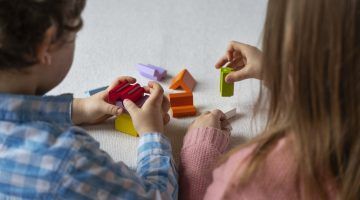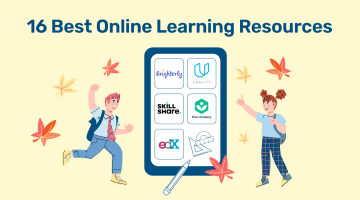40 Basic Classroom Rules For Kids
reviewed by Franz Jerby Delos Santos
Updated on November 12, 2025
If you have ever tried to explain any subject to a kid (or a group of kids), you know that keeping their attention can be difficult. They’re looking the other way, distracted by their phones, and losing focus. For any educator (or a parent), basic classroom rules for kids are in order.
I’m a professional math tutor, and today, I’ll walk you through the best classroom rules to keep children focused, engaged, and ready to learn.
Key Points
- Classroom rules should be ethical, focused on respect, participation, curiosity, and positive reinforcement.
- From preschool to high school, rules teach responsibility, cooperation, and respect. They are vital for any society, and are essential life skills that extend beyond the classroom walls.
- Brighterly is an e-learning platform that brings together an adapted curriculum, a school-aligned program, and positive classroom rules.
What are some good classroom rules?
Good classroom rules are simple rules. They are consistent and ethical, focused on respect, participation, and curiosity. School rules for kids are supposed to guide students to listen, stay on track, and treat classmates and the teacher kindly, but not restrict their creativity or self-expression.
Note: Even the best rules work better when they’re supported by positive reinforcement and an encouraging learning environment.
Virtual classroom rules for elementary students on e-learning platforms like Brighterly
Brighterly math and reading platform is one of the esteemed e-learning platforms for students in grades 1–9. They bring principles of respect, participation, gamification, and curiosity to online tutoring. Brighterly’s virtual classrooms follow clear and engaging basic classroom rules to help kids focus, enjoy learning, and build confidence through 1:1 adapted learning.
Top Brighterly features
- Math and reading tutors specialized in online education
- Adapted curriculum aligned with the school standards
- Free educational resources
Math and reading tutors specialized in online education
Brighterly’s feature I love most is definitely its expert teaching staff. No educational company can run without top educators, and Brighterly is no exception. The platform only collaborates with certified math and reading teachers who specialize in online education. And as I’ve examined hundreds of parental reviews about Brightelry (4.4 excellent score on Trustpilot!), I can confidently say — kids love the tutors and parents love the impact they make.
Adapted curriculum aligned with the school standards
While other platforms use proprietary methods of teaching, Brighterly follows the school standards along with the classroom rules and expectations of the U.S. education system. If you’re looking for a comprehensive math and reading program that is fully aligned with the school’s standards, Brighterly is for you.
Note: The school-aligned curriculum means that children follow grade-level requirements and guidelines, and progress made at home with a tutor directly translates into performance in school.
Free educational resources
With Brighterly, you can get educational resources for free — no signup or credit card required. Math or reading worksheets are available in PDF format for everybody who is looking for a cohesive solo learning experience.
Brighterly’s pricing
The average tutoring rate in the United States is between $40 and $80 (expect to pay upwards of $300 a month for one lesson a week). Alternatively, Brighterly’s pricing starts at $17.3 per lesson. You’ll get this convenient price if you book a 12-month membership, with 3+ weekly lessons.
Rules for kindergarten class
- Arrive on time to class.
- Listen when someone is talking.
- Raise your hand to speak or before leaving your seat.
- Keep your hands, feet, and objects to yourself.
- Use kind words and gentle voices.
- Take care of your classroom and its materials.
- Share and take turns.
- Try your best and don’t give up.
- Walking unsafely inside the classroom is prohibited.
- Be respectful, responsible, and ready to learn.
When creating classroom rules for kindergarten, you have to use language kids understand, so simple language is a must.
Note: Having a clear, effective classroom rules list for kindergarten is like setting boundaries of a game. They provide structure that kids can understand and follow, and create an efficient environment for learning, exploring, and managing the class.
Now, let’s explore elementary classroom rules examples.
Classroom rules for elementary students
- Listen carefully and follow classroom rules & directions.
- Raise your hand to speak or ask a question.
- Respect your teacher, classmates, and school property.
- Use kind words and actions.
- Stay in your seat unless you have permission to leave.
- Always try to do your best at a specific moment.
- Be prepared and ready to learn.
- Stay positive and never give up.
- Ask questions when something is unclear to you.
- Help others and include everyone.
Elementary is a step up from preschool, and even though the classroom rule ideas stay almost the same, expectations become higher and stricter as kids grow older and become more conscious.
Note: Classroom rules for elementary school establish and enforce a stable and predictable atmosphere, allowing students and teachers to focus on teaching. Classroom rules for 1st grade help children build good habits, develop respect for one another, and make the classroom a safe space for everyone.
Top 10 classroom rules for middle school
- Be on time and prepared for the class.
- Listen when others speak.
- Follow the directions of the teacher.
- Don’t disrespect classmates, teachers, or school property.
- Keep phones and devices put away unless allowed.
- Use appropriate language and tone.
- Participate actively and stay focused.
- Take responsibility for your actions and words.
- Complete your assessments according to the directions and on time.
- Support a positive and inclusive environment.
Our society is built on rules. They create order, promote fairness, and help communities function smoothly. Middle school classroom rules and expectations are just as important as those that guide the words outside the classroom.
Note: Middle school is when kids should pay special attention to mutual respect — towards their educators and peers.
Classroom rules for high school
- Arrive on time and be prepared to learn.
- Respect everyone’s opinion and personal space.
- Listen actively when someone is speaking and ask questions.
- Follow the instructions and directions.
- Use your phone or any other kind of technology when it’s allowed.
- Participate actively in discussions and school work.
- Submit assignments on time and take pride in your work.
- Keep a positive attitude, encourage others, and set positive expectations.
- Take responsibility for your actions and choices.
- Contribute to a respectful, focused, inclusive, and successful classroom environment.
Once kids get to high school, everyone expects them to be more mature, not needing a single classroom rule. But you’d be surprised to learn that you’d need more stringent classroom rules in some cases. Without classroom rules for high school, every day would be a potential minefield of distractions, making it almost impossible to get through a lesson without misbehavior and distractions.
Note: What’s most important for high schoolers is collaboration and participation. These learning elements improve their social skills, and teach them to communicate more effectively, expressing their thoughts in a logical way.
Classroom rules guide: How to build the perfect set
Don’t get mistaken that writing classroom rules is an easy task. In fact, compiling your list requires knowing general recommendations, plus accounting for the specificities of your classroom. To achieve the best results, please try to follow these rules.
Balancing strictness and flexibility
Following rules that are too strict is not pleasant. If you’re an educator, you know that there is such a thing as being too strict when setting basic classroom rules for elementary and beyond. And with kids with behavioral issues, these, plus subtle threads, won’t do much.
For example, some classroom rules for elementary and middle school may include punishments. However, some kids simply won’t respond to these. Similarly, with older students in high school, you’ll find that tension in the classroom is something they find funny and amusing.
Alternatively, you can’t be too flexible and let anything go in your class. Your job as a teacher is to mold children into decent adults who are able to live in society. One way to do that is to strike a balance between strict rules and flexibility.
Using positive language in rules
When you are laying out classroom rules 3rd grade (and any grades), you must ensure that you are using positive language. You are not just a teacher; you are an example to them.
So, if you’re giving rules about how they should speak to each other and you’re using negative language, it is almost antithetical. No matter how frustrated you are or how serious you want to sound, you must always maintain a positive tone.
Making rules understandable and clear
When you’re giving out rules for a classroom, there should be no ambiguity for your students. In other words, a lot of things can be lost in translation. Some students may claim they did not understand the rules, even if you laid them out correctly.
To make your rules more understandable, use clear English, simple words, and familiar vocabulary. If you have some visuals, add them to convey the message. This way, your students will confidently say, “We stand by our classroom rules.”
Keeping rules accessible and visible
People, especially children, tend to forget things. The first time you say it, the second time you send it, and maybe even the third time you say it, they can claim they didn’t remember. You can’t force them to change their minds. However, you can keep your positive classroom rules in a place where everybody can access and see them. That way, they can’t claim they didn’t remember; they definitely can’t say they didn’t see it.
Place it where, every time they enter the classroom or glance up from their books, it’s a constant fixture. Make it so prevalent that there are no excuses.
Avoiding over-complication
It can be easy to overcomplicate things when giving examples of classroom rules, but as a teacher, you need to make a conscious effort to simplify your classroom rules down to the minutest detail. When giving classroom rules, use language kids understand. If they ask you more than two times to explain what you’ve said, it might be too complex. Break it down further. The goal is for the kids to understand and adhere to these rules. If the rules are too complex, they won’t adhere to them, causing problems in class.
Why are classroom rules important?
- Classroom rules create a safe and respectful environment
- They build consistency and structure
- They teach responsibility and accountability
- They support better learning and engagement
- They promote a positive classroom culture
They create a safe and respectful environment
To create a positive classroom, safety and respect count. One classroom rule says: Respect everyone’s opinion and personal space.
When students know what behavior is acceptable and what isn’t, they feel more secure and supported. Believe it or not, clear rules protect students from bullying, disruption, and emotionally unsafe situations. A safe classroom allows students to express themselves without fear of judgment and encourages them to participate, ask questions, and share ideas.

They build consistency and structure
When the environment is predictable, children thrive. Classroom rules give kids a sense of order and stability, allowing them to understand what to expect day-to-day. The structure that comes with classroom rules and expectations reduces anxiety, supports concentration, and makes lessons run smoothly.
They teach responsibility and accountability
Personal responsibility is one of the most valuable lessons students can learn in school. When they follow agreed-upon guidelines, children realize their choices have consequences, both positive and negative. Once students take ownership, they learn how their behavior affects others.
They support better learning and engagement
Classrooms without clear rules can become chaotic. This is why educators implement clear rules to set boundaries and minimize distractions, so kids can focus on the subject at hand. Once everyone is on the same page regarding how to behave and what to expect, lessons flow smoothly and time is used more effectively.
They promote a positive classroom culture
The best classroom rules don’t just manage behavior. They help shape how the classroom is approaching learning and create a positive atmosphere. Rules emphasize respect, teamwork, and kindness, so that students can internalize these values and express them openly in the world.
Conclusion
Classroom rules and expectations are an important staple of education. They help create those positive experiences, make the learning effective, internalize the right values, and promote discipline. Both teachers and students benefit from these rules, and it certainly boosts kids’ performance in school.
Brighterly follows the same principles in its online math and reading lessons. By setting clear, simple, and effective virtual classroom rules, the platform helps kids focus, build confidence, and improve their skills to succeed in school and beyond. Book free lesson to power up your kid’s learning experience!















